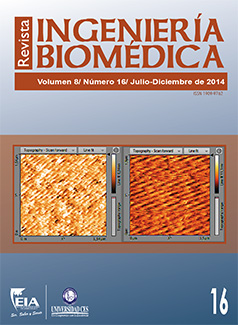Análisis lineal y no lineal de los esfuerzos en pilares de circonio preformados. Elementos finitos
Análisis lineal y no lineal de los esfuerzos en pilares de circonio preformados. Elementos finitos
Barra lateral del artículo
Licencia
![]()
Esta obra está bajo una Licencia Creative Commons Atribución-NoComercial-NoDerivativa 4.0 Internacional
Contenido principal del artículo
Resumen
Resumen ─ Este estudio pretendió determinar el comportamiento mecánico entre pilares de Zirconio Zimmer® con anillo de Titanio en la base y sin ella, utilizando el método de análisis de elementos finitos Métodos: se diseñaron dos modelos de pilar en Zirconio sobre implante, conformados además por un implante de Titanio Zimmer® tornillo de unión, hueso cortical y hueso esponjoso y una corona cerámica de un incisivo central superior. Se aplicó fuerza en sentido oblicuo con una magnitud de 200N, ascendiendo en escala de 200N hasta que algún elemento superara el límite de proporcionalidad. Se calcularon los esfuerzos von Mises para cada elemento. Resultados: No se observaron diferencias en la magnitud de los esfuerzos de von Mises entre el pilar con anillo de Titanio y sin él; (280,1 MPa con anillo en Titanio, 280,4 MPa sin él) pero sí en el tornillo y el implante, siendo menores los esfuerzos para el modelo con anillo de Titanio (474 MPa 15 vs 576,7 MPa). El hueso y la corona reportaron no linealidad a 600N, implante y tornillo a 1000N y ambos pilares de Zirconio a 1400N. Conclusiones: Cuando el esfuerzo de precarga aplicado a ambos modelos es el recomendado, no hay diferencias entre los dos pilares.
Abstract ─ The purpose of this study was to determine the mechanical behavior between Zimmer® zirconium implant abutments with and without a titanium washer at their base, by using the finite element analysis (FEA). Materials and Methods: two models of a zirconium abutment on implants were designed, composed of a Zimmer® titanium implant a fixation screw, cortical and cancellous bone, and the ceramic crown of an upper central incisor. An oblique force was applied with a magnitude of 200N, ascending in a scale of 200N until any of the components of the model exhibited a nonlinear behavior. Von Mises stresses were calculated for each element. Results: No significant differences on von Mises stresses were observed between the abutments with and without a titanium washer (280, 1MPa with a titanium washer, and 280, 4 MPa without it) but differences were found at the fixation screw and the implant: the stresses were lower in the model with a titanium washer (474MPa vs 576,7MPa). Both the bone and the crown exhibited non linearity at 600N, the implant and the screw at 1000N, and both zirconium abutments at 1400N. Conclusions: When the preload stress applied to both models is the adequate, no mechanical behavior differences between the abutments occur.


 PDF
PDF
 FLIP
FLIP







